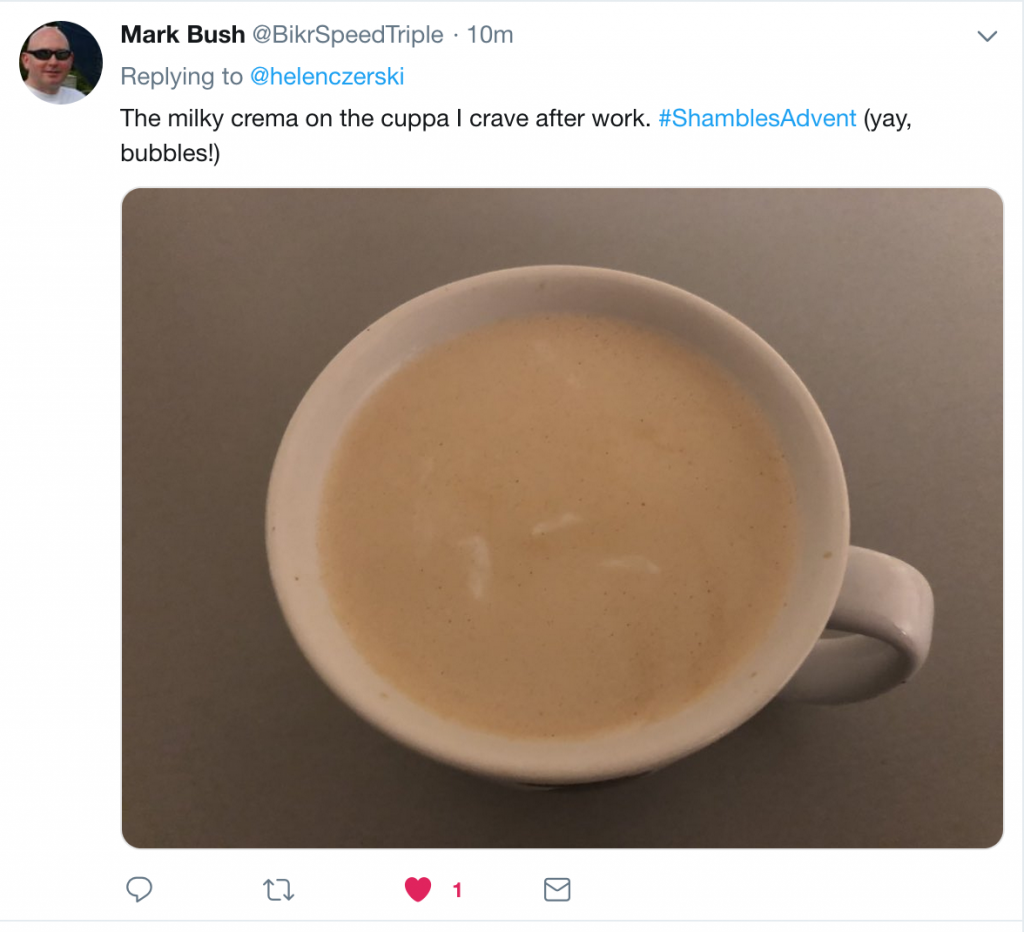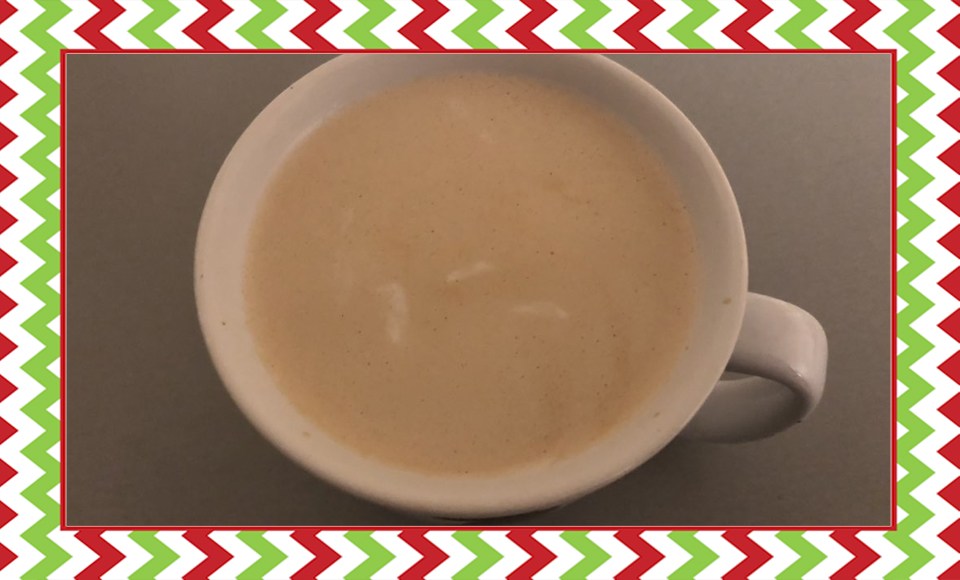Day 8 - Shambles Advent
Blog in a Teacup by Dr Helen CzerskiDay 8 – @BikrSpeedTriple
Every day until Christmas Dr Helen Czerski will be finding some cool, hidden science in pics of people’s every day lives. To get involved, tweet your pic to @helenczerski and @cosmicshambles with the hashtag #ShamblesAdvent

Hooray for @BikrSpeedTriple, who gave me both bubbles and a teacup in the same picture! This gives me an excuse to tell you about one of my favourite teacup games, and you can play it with or without the tea (do both and pay attention to the difference, but try an empty cup first).
Here’s the game: take a teaspoon or something of similar size and mass, and tap the rim of the teacup. Listen to the sound that makes, and then work your way around the rim, tapping as you go. You’ll hear a change in pitch as you go round. Tap until you’ve spotted the pattern. If you don’t like spoilers, pause here for a moment and try it to see what you find out. If you can cope with a spoiler, read on for a description of what’s going on before you try it.
…
…
…
What you’ll find is that the pitch of each tap is lowest when you’re directly opposite the handle, or at right angles to that position. If we look at Mark’s photo, and mentally nudge it a bit so that the handle is at 3 o’clock, tapping at 6 o’clock, 9 o’clock and 12 o’clock will give you low notes. Tapping halfway in between those positions (halfway between 1 o’clock and 2 o’clock, for example) will give you the highest pitch.
The reason that you’re hearing a sound is that the tap sets the cup vibrating, and things naturally vibrate with quite specific patterns. In this case, there’s one dominant pattern. Hold both hands up to your screen so that your thumbs touch and your first fingers touch, making a circle around the picture of the cup. First of all, squish this shape so that the two spots that touch get a bit closer together. You’ve got a horizontal rugby ball shape. Then squish that shape the other way, so that your hands get closer together, and the touching points get further apart. Now you’ve got a vertical rugby ball shape. Now go quickly from one to the other. On a tiny scale, the top of the cup is oscillating like this, bulging and squishing. As it goes, it pushes on the air around it and that sends out sound. So although you can’t see that oscillation, you can hear it. Slower oscillations give you deeper notes, and faster oscillations give you higher notes. The place that you hit the teacup is one of the places that moves the most, 9 o’clock if you hit the cup opposite the handle.
So now we come to the important question: why does this produce a low note in the case that you’ve just demonstrated, and a higher note if the shapes are at 45 degrees to this? Look through your hands at the teacup again, and stretch and squish the shape. You’ll see that the handle of the cup is at a position that is moving a lot. Now tilt your shape clockwise, so that the rugby balls are at 45 degrees. You’ll see that the handle is now in a position that isn’t moving at all.
Here’s the answer: the handle has mass. When you hit the cup in a way where you force the handle to move, you’re effectively hitting a heavier object because of that extra mass. So it oscillates more slowly and rings with a lower note. When the handle doesn’t move, it might as well not be there, so you’ve got a nice light cup. It can oscillate faster, making a high note. By listening to the pitch of your tap, you’re learning something about the mass of the mug. There are a few extensions to this too: compare the notes made by tapping different mugs, and see what happens as you drink your tea, and the level of drink in the mug goes down. I’m not going to tell you: have a play and see what you can work out
I’m not sure that anyone in the UK needs an excuse to drink more tea, but this is the perfect scientific justification, just in case it comes in handy over the festive period.
Catch up on all the open windows of Helen’s Shambles Advent here.
The Cosmic Shambles Network relies on your support on pledges via Patreon so we can continue to provide great, new, exciting content without the need for third party ads or paywalls.
For as little as $1 a month you can support what we do and get some great rewards for doing so as well. Click the Patreon logo to pledge or find out more.
 Dr Helen Czerski is a physicist, first and foremost, but she’s acquired a few other labels along the way: oceanographer, presenter, author and bubble enthusiast. A regular on The Cosmic Shambles Network, she has also presented a number of acclaimed documentaries for the BBC and her first book, Storm in a Teacup, which looked at the physics of every day things, was a bestseller. Recently she was awarded the prestigious William Thomson, Lord Kelvin Medal and Prize from the Institute of Physics.
Dr Helen Czerski is a physicist, first and foremost, but she’s acquired a few other labels along the way: oceanographer, presenter, author and bubble enthusiast. A regular on The Cosmic Shambles Network, she has also presented a number of acclaimed documentaries for the BBC and her first book, Storm in a Teacup, which looked at the physics of every day things, was a bestseller. Recently she was awarded the prestigious William Thomson, Lord Kelvin Medal and Prize from the Institute of Physics.
If you would like to reuse this content please contact us for details
Subscribe to The Cosmic Shambles Network Mailing list here.


